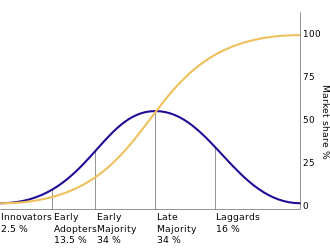This picture below is Everett Rogers.



There are five different adopter categories where these ideas are taken under consideration
1. Innovators are the first people in this first stage and these are the people that get this product from the very start. This stage includes around 2.5% of people who use this technology. These are the people who use the product from the start and out of all the people in this group they are the group that takes risks. These are people who want to try products and use them no matter what the outcome is.
2. Around 13.5% of people are the early adopters and these are the people that believe that change is needed for success. These are people's opinions that you can trust and you normally can ask them about the product. At this stage is when the product begins to become more popular overtime.
3. 34% of these people are the early majority and these are the ones who like to see the full capacity of the product. They want to see to make sure it works and is good.
4. The other 34% of people in this group are the late majority and these people are normally against change at first but, they will eventually come around and buy the product if they are really challenged to.
5. The final 16% of these people are called Laggards. These people are normally against buying the product and they are very conservative. They don't want to steer away from their beliefs or ideas.

One of the biggest innovations that I can relate to the diffusion theory is the concept of music streaming. This is something that has been becoming extremely popular over the last few years especially with technology continuing to become more available to everybody more easily all the time. This has been adopted by many recently and I am going to explain the users of music streaming platforms such as Spotify and where they fit into this theory.
When it comes to the innovator stage the people that can be grouped within this stage these are tech savvy people who developed this invention and also tech enthusiasts along with some music enthusiasts. These people appreciate Spotify's amazing approach to music streaming and the execution of it.
The general public was the early adopters and early majority portion of the service. One of the biggest reasons this is because of their "Freemium business model". How this works is that users could use the basic model of this app and listen to music with ads and not pay for the premium plan. A fair amount of people would later go on and purchase the premium plan of the app and Spotify would go on to gain most of their market share here.
Then there are the late adopters such as myself. This includes people who were skeptical to joining Spotify or people who were using different formats to listen to their music such as cds and vinyl. This group will then join Spotify later after the slower uptake of the platform.
The last stage is the laggards phase where these are the people who are against the change and also who have limited access to digital tools.
This theory is only going to continue to grow with new forms of media and technology thart are being developed.
No comments:
Post a Comment